Main Theme
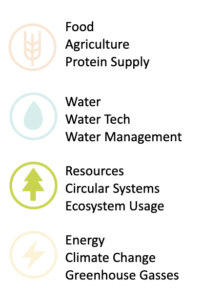
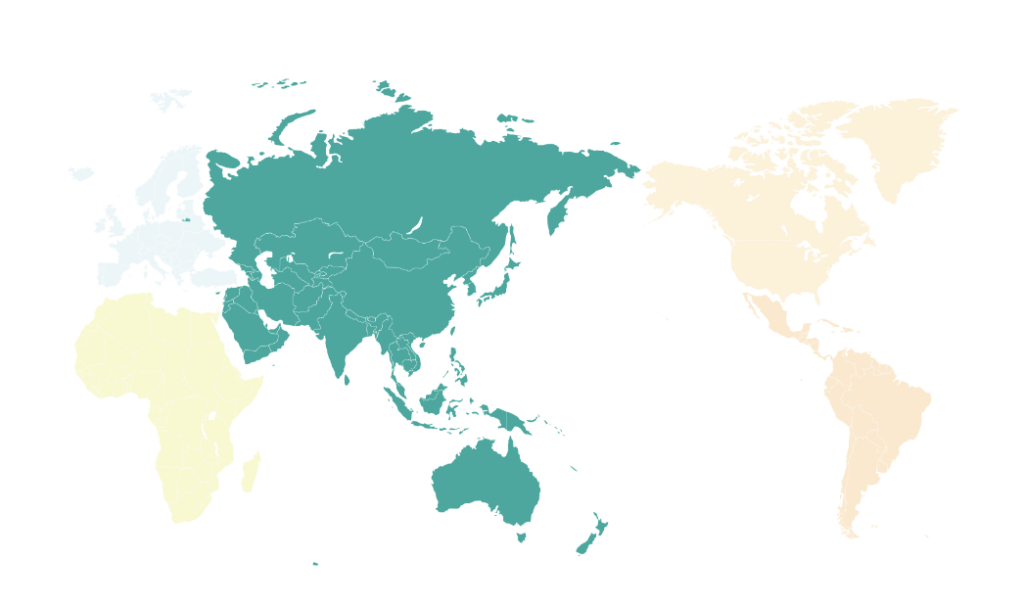
Sub-theme: plastic waste; greenwashing; sustainable packaging.
Abstract
Asia’s economic growth and population density puts it at the center of the plastic waste problem. With a very high rate of waste mismanagement, the region accounts for more than 50% of the plastic leakage into the world’s oceans. This challenge is very prevalent in developing Asian economies as compared to high-income countries where most plastic waste is incinerated, recycled, or sent to well-managed landfills.
The packaging sector is responsible for about 50% of all plastic waste generated and is a key focus area for Asia because of the rapidly growing demand for convenient packaging. Due to this consumer demand, initiatives like bans on plastic packaging are not effective. As a result, sustainable alternatives to plastic in the packaging sector are a big need and opportunity for Asia to improve waste management in the region.
Invisible, an organization based in Hong Kong, provides a truly biodegradable alternative to plastic for packaging dry goods, made from plant-based products. Invisible’s approach addresses the greenwashing of products claimed as sustainable alternatives – such as oxo-biodegradable plastics, made from fossil fuels which lead to the generation of micro-plastics. Invisible has helped prevent the use of two million plastic bags since 2020; helping reduce the five trillion plastic bags that get thrown away every year, globally.
Sustainable Development Goals Chart

Main Highlights
Plastic scenarios in Asia
- 51% of the world’s plastic is produced in Asia
- Over 50% of the plastic waste in oceans is from Asia
- High-income countries are better in managing their plastic waste than developing economies
Packaging plastic initiatives in Asia
- Packaging sector is responsible for almost half of all the plastic waste generated
- Plastic product bans have a very little long-term impact on their own
- Effective alternatives that reduce plastic inputs into the system is a key focus area
Invisible: Truly biodegradable plastic alternatives for packaging
- Biodegradable plastics are most susceptible to greenwashing because oxo-biodegradable plastic (OBP); made from fossil fuels, and leads to the generation of micro-plastic
- Invisible Bag is water-soluble, compostable, biodegradable, proven to be non-toxic, and leaves no harmful residue on earth
- Invisible Bag caters to applications such as garment packaging, shopping bag, mailers, packaging puffs, and poop bags for pets
Impact of truly biodegradable plastic alternatives
- Since 2020, Invisible has replaced 2 million conventional plastic bags with Invisible Bags
- Invisible uses naturally occurring resources and eco-friendly ink for manufacturing
- High tensile strength of Invisible bags improves its lifecycle
A systems perspective on sustainable packaging
- Invisible’s packaging products are not water resistant or repellent – meaning they are not suitable for the food and beverages industry
- Another challenge is when sustainable packaging products interface with plastic
- Challenges to sustainable packaging will to drive material innovations in the sector
Case Overview
Almost half of the world’s solid waste (or trash) gets generated in Asia; plastic accounts for about 10% of this solid waste. Countries with stronger economies create higher volumes of plastic waste but have better plastic collection and recycling efficiencies. Since most of Asia has developing economies, most of the plastic waste remains uncollected. Plastic waste originates from packaging, electronics, household items, stationery, healthcare, and more.
Uncollected plastic waste pollutes the environment, mainly soil and water. Currently, over 50% of the plastic waste in oceans is from Asia, which negatively impacts marine life and eventually life on land. Understanding the sources of plastic (production), its applications (use), and end-of-life management (collection, re-use, recycling, upcycling) is essential to identify the most promising channels to solve Asia’s growing plastic waste challenge.
Plastic production, consumption, and waste scenarios in Asia
Asia is a prime global hub in the plastic ecosystem; 51% of the world’s plastic is produced in the region. Per capita, high-income countries consume larger volumes of plastic. High-income countries (like Japan) are also among the biggest exporters of plastics, globally.
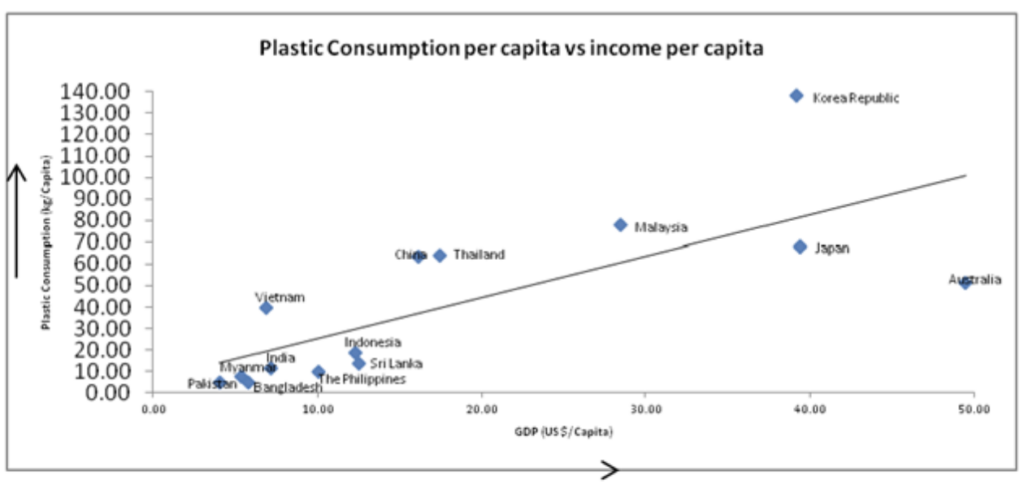
Asian countries (especially China) also are the world’s largest importers of plastic waste. The imported plastic is used as raw material to create recycled plastic products. Along with such high intensity of commercial activities with plastic, over 60% of the plastic waste in Asia is mismanaged. High-income countries manage their plastic waste by incineration, recycling, or sending it to well-managed landfills.
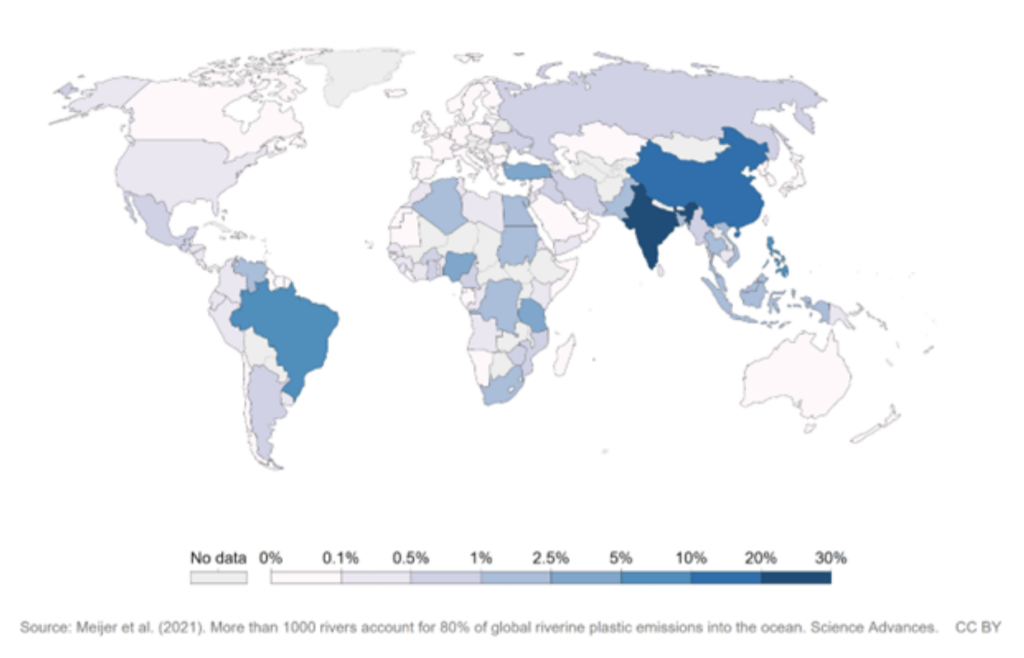
Which countries produce the most mismanaged plastic waste? [Source: OurWorldInData]
Despite the high per capita consumption of plastic, high-income countries fare much better in managing their plastic waste than low or growing economies. Mismanaged plastic waste is the sum of used plastic that is either littered or inadequately disposed of.
Plastic waste generation is strongly influenced by primary plastic use, but also by the product lifetime. In this context, the packaging sector is responsible for almost half of all the plastic waste generated – and much of it is mismanaged. So, initiatives that focus on the packaging sector are likely to have a higher impact on reducing plastic mismanagement in Asia.
Plastic waste management initiatives in Asia’s packaging sector
Over the past decade, the global packaging industry has steadily grown, with the economic boom in emerging countries in Asia, a key growth driver. Important developments include the strong growth of organized retail and increased use of packaging to accommodate consumer demand for convenience. Asia’s packaging sector creates and wastes plastic for applications such as – household cleaning products, food deliveries, packaged food, meat, frozen food, pet food, fresh fruits and vegetables, beverages, and more.
To address plastic waste from packaging, a ban on plastic products is a very common government initiative in Asia. However, due to the lack of practical alternatives and weak regulations in plastic production, the bans have very little long-term impact on their own. So, what are the initiatives and innovations that will have the highest impact on reducing plastic waste from packaging in Asia?
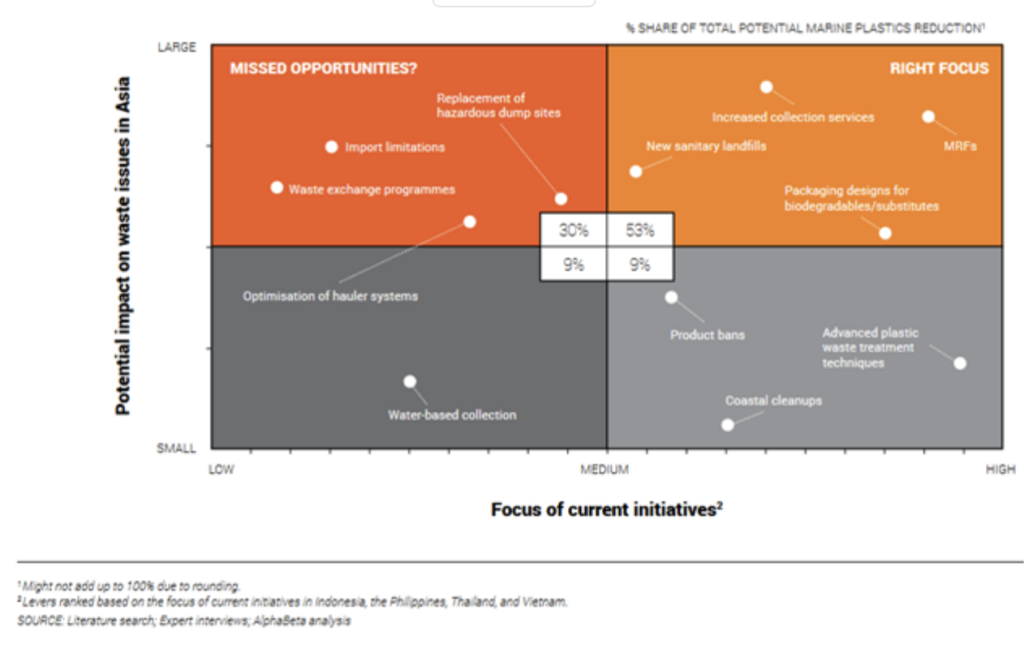
Initiatives for plastic waste management and their impact on waste issues in Asia; showcasing current and future alignment for high impact. [Source: AlphaBeta]
Broadly, the initiatives and innovations can be categorized as –
- Reducing plastic inputs into the system (e.g., using alternatives to plastic)
- Enhancing collection rates for end-of-life (after-use) plastics (e.g., decentralized collection services)
- Plugging leakage post collection of plastics (e.g., material recovery facilities/MRFs)
- Creating value for plastic waste reuse (e.g., advanced waste treatment)
The waste management hierarchy explains that the strongest way to manage waste is by preventing it. Switching to effective alternatives that reduce plastic inputs into the system is a key focus area for mitigating plastic waste from Asia’s packaging sector.
Invisible Bag: Truly biodegradable alternatives to plastic
Alternatives to plastic packaging include materials and material innovations in cloth, paper, glass, metal, and plastic itself. Material innovations in plastic are bioplastics (such as from natural materials, or organic waste) and biodegradable plastics.
Biodegradable plastics are most susceptible to greenwashing because oxo-biodegradable plastic (OBP) leaves behind micro-plastic which enters the system and negatively affects the quality and the economic value of the end-of-life plastic. While OBPs are technically biodegradable, they take a very long time to break down and leave behind harmful micro-plastics.
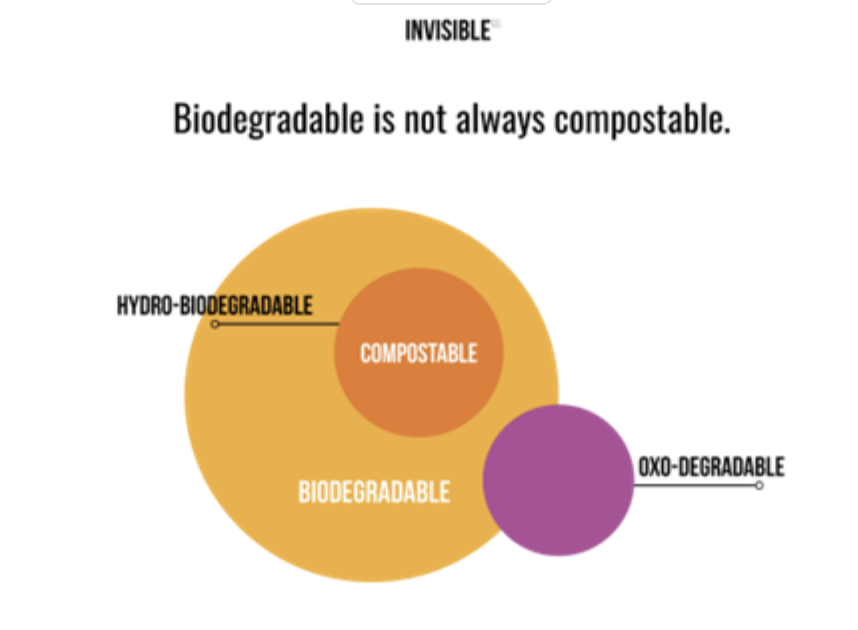
Oxo-biodegradable vs. Hydro-biodegradable. [Source: Invisible]
Hydro-biodegradable plastics (HBPs), in comparison to OBPs, are compostable as well as truly biodegradable. They are made from naturally occurring sources (such as starch, corn, wheat, sugar cane, and/or petroleum). HPBs break down into carbon-di-oxide and water, leaving nothing else behind.
Invisible Bag is water-soluble, compostable, biodegradable, proven to be non-toxic, and leaves no harmful residue on earth. It is an alternative for manufacturers and brands to replace conventional plastic packaging. Invisible Bag is made of a water-soluble and biodegradable combination of Polyvinyl Alcohol (known as PVA), starch, glycerin, and water. One of the primary ingredients, Polyvinyl Alcohol (PVA), is a water-soluble and biodegradable synthetic polymer.
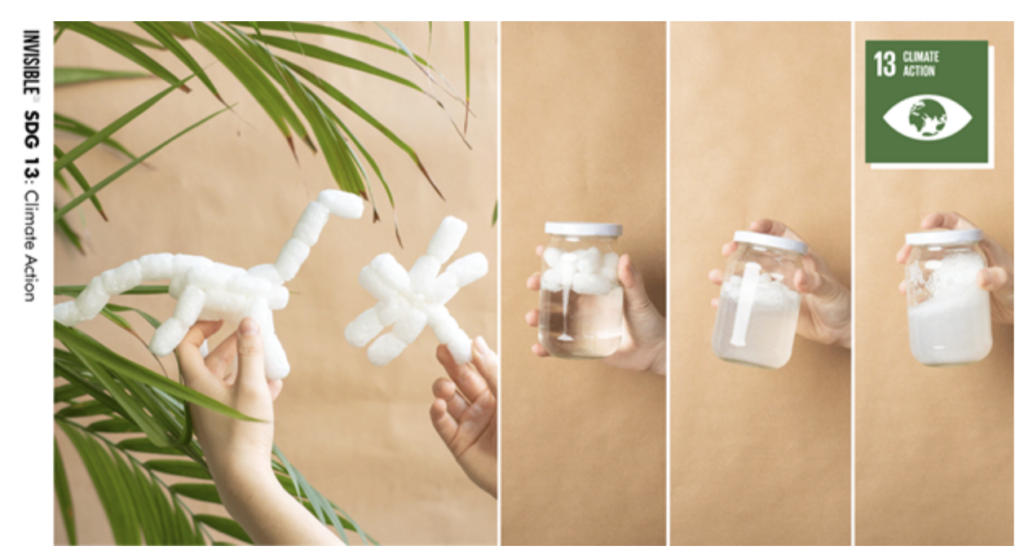
Made of corn starch and glycerin, the eco-packing-peanuts Invisible Puff was introduced by the end of 2021. [Source: Invisible]
Apart from custom packaging solutions, Invisible Bag caters to applications such as garment packaging, shopping bag, mailers, packaging puffs, and poop bags for pets; across Hong Kong, Taiwan, Singapore, Malaysia, and Thailand. Since its inception in 2020 in Hong Kong, Invisible Bags have prevented two million conventional plastic bags from entering the system. Invisible Bag is looking to prevent the use of ten million conventional plastic bags by 2023 by influencing businesses as well as individual consumers.
Though affordable and accessible, Invisible’s HBP alternatives suffer from one major limitation: they cannot be used for liquid-related applications and during wet seasons of the year (since they dissolve in water). For impact at scale, which can mitigate the five trillion plastic bags thrown away each year, the dry goods application of Invisible Bag needs to be complemented by material innovation for liquid-related use-cases.
Impact Statement
Asia has the highest rate of mismanaged plastic waste (~ 60%) in the world – especially in its developing economies. The packaging sector accounts for about half of all the plastic produced and wasted. Effective alternatives to conventional plastic packaging will prevent plastic from entering the system and reduce the overall rate of mismanaged plastic waste. Invisible, based in Hong Kong, is enabling this outcome by providing truly biodegradable plastic packaging for businesses and consumers.
Sustainable consumption and production of packaging material
Despite viable plastic alternatives available in the market, five trillion plastic bags are thrown away each year, globally. Since the year 2020, Invisible has replaced 2 million conventional plastic bags with Invisible Bags; aiming to replace 10 million by the year 2023. They are achieving this outcome by directly collaborating with businesses, and by improving education and awareness among consumers – especially young people.
Climate action through responsible packaging design
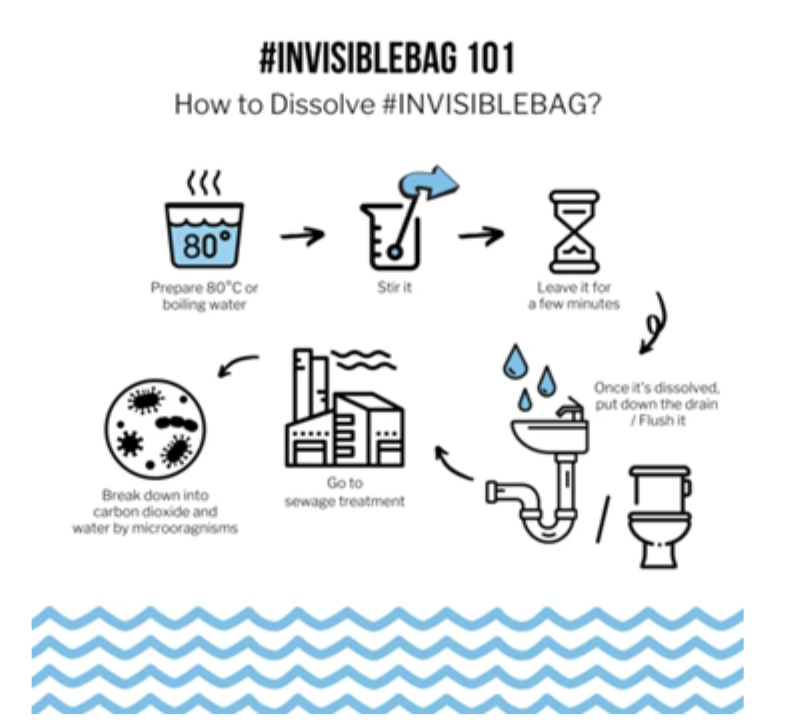
How to dissolve Invisible Bag? [Source: Invisible]
Micro-plastics entering the system is one of the biggest downsides of many biodegradable plastic packaging products available in the market. Such products are an example of the greenwashing that is prevalent in the Asian market. In comparison, Invisible’s products for sustainable packaging are truly biodegradable – leaving behind just water and carbon-di-oxide after they break down. Additionally, Invisible’s products use naturally occurring resources and eco-friendly ink for manufacturing.
Limiting plastic packaging waste from entering oceans
Asia (particularly the Philippines) is the world’s single largest contributor (over 50%) to plastic leakage into the ocean. This is driven by the high rate of mismanaged waste and the rising demand for convenience in the region. Invisible’s packaging products can be used (and re-used) for a variety of dry goods packaging because they have high tensile strength, are non-conducting, and are oil/grease resistant. When businesses and consumers use Invisible packaging, it reduces the need for plastic collection, eventually decreasing the leakage of plastic into marine systems.
Systems Perspective
The packaging sector in Asia is a key focus area for the consumption of plastic and the generation of plastic waste. While collection and recycling are commonly considered the critical pain points for plastic waste management, material innovation in packaging highlights the importance of preventing plastic use and increasing the lifecycle of packaging solutions.
Consumers are showing increasing concern about the negative effects of plastic packaging because of how it affects life underwater as well as life on land. As a result, the market size and consumer demand for packaging alternatives like cloth, paper, metal, glass, and biodegradable plastic is growing in Asia. There is a willingness to way for more eco-friendly packaging, but that is a barrier to scaling since five trillion plastic bags get discarded around the world, annually.
Invisible’s hydro-biodegradable packaging products are addressing plastic waste mismanagement by preventing plastic use and increasing the lifecycle of products – in an accessible and affordable manner. The packaging products cater to any dry goods applications – and complement other similar solutions from companies like Evoware, Bambrew, and W-Cycle, among others.

However, Invisible’s packaging products are not water resistant or repellent – meaning they are not suitable for the food and beverages industry in their current form. By integrating with a sustainable water-repellant coating, Invisible could become open to an even more diverse set of use cases.
Another challenge is when sustainable packaging products interface with plastic. For instance, plastic (and paper) adhesive tapes are a big part of the overall packaging of a product. Invisible continues to have a disclaimer that consumers need to cut and dispose of the adhesive tape strip before dissolving their garment bags or mailer bags. This is a segregation-at-source challenge, which is a pain point of waste management models. Also, greenwashing by oxo-biodegradable plastic packaging (that leave behind micro-plastics), is a very prevalent problem in Asia.
The challenges to sustainable packaging will continue to drive material innovations in the sector. This is a high-impact opportunity area for Asia to improve its management of plastic waste, especially in developing economies. Along with solutions for collection, recovery, and waste processing – the sustainable packaging sector will enable plastic-free lifestyles in society.
Links and Contact Information
Invisible Company aims to create a community based on authenticity and fairness, built upon our sustainable and innovative products; to inspire, educate and spearhead environmental change. The company was founded in 2020 by Flavien Chaussegros and Devana Ng.
Case by: 4Revs Project Manager Shravan Shankar | August 2022

